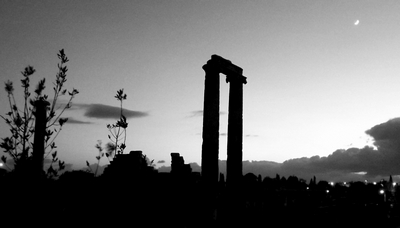HOW time rushes past faster than the Doppler Effect. Now all we can view is the diminishing red-shift as it fades into that oblivion of mere memories. Though what memories they truly were.
British Museum
2017 was delightfully prefaced by my visit to the British Museum to meet Dr Ian Jenkins, senior curator responsible for the Greek and Roman Antiquities Department.
A most charming, eloquent and extremely helpful man, he directed me towards another level of academic research and encouraged me to continue the work I’ve been conducting around the Temple of Apollo. I trust I have not disappointed.
Reconnaissance of the stones
Upon my return to Didim I soon commenced research which has led to the theme of my articles for ‘Voices’ throughout this year.
Whenever the weather permitted I was to be found around the Temple taking photographs of the mainly buried sites to get a feel for the lay of the land, postulating the connection of one site to another and sometimes just sitting there imagining how the entire site would have appeared in its halcyon days.
I quickly discerned the areas to the northeast and southwest of the Temple would probably hold the most valuable archaeological secrets; the extension of the Stadium to the southwest, now under some tumbled down, but inhabited, abodes and to the northeast, again strewn with the dilapidated relics of another less interesting recent age, surely the site of the palatial villas of the elite of Milesian and Roman society.
To my knowledge, and I have enquired extensively, no archaeology has ever been undertaken in those areas.
The finding of gold
It is rather a cliché, though ‘all that glitters’ certainly ‘is not gold’, but such finds have proved an invaluable tool throughout this year.
Firstly, I was sent a copy of Joseph Fontenrose’s book, ‘Didyma. Apollo’s Oracle, Cult and Companions’ (1988). This book, though somewhat dated, remains the key source book for the entire archaeological site surrounding, and including, the Temple. No one writing of ancient Didyma should fail to read this absolutely beguiling treatise.
Next arrived a most beautiful engraving of the Temple before any excavation work had commenced (1835), produced by the renowned French explorer Charles Texier. My German friend owns the copyright and was pleased to allow me to use the engraving in any way that I saw appropriate.
Thirdly, from Norway, I was sent the photographs of the model of the Temple of Apollo, displayed in Germany during 1986, showing how the Temple would have appeared as it neared completion.
I am sure that they must have made an immense impression upon all who recently saw these images in ‘Voices’.
That was followed by a link to the University of Heidelberg, where I was able to download a copy of the Dilettanti Society’s ‘Antiquities of Ionia’ (1821). A book which documents the Survey Expeditions to, among other places, Didyma, and a source which Dr. Jenkins had urged me to find. I was delighted to read through those pages and ponder over the maps which offer tantalising glimpses into possible traces of our past.
The excavations by the team from the University of Halle during August were hindered by a lack of preparation due to events outside of their control.
It was still a pleasure to meet them even though they had to remain tight lipped this year about their activities. Even so, they could not prevent me looking for myself, though the only point of real interest, to me, was the discovery of either a well or a pit for votive offerings abutting the Temple of Artemis’ north wall. Hardly thrilling compared to previous years.
‘Cherry on the cake’
Therefore, a fine cache of literary gold was unearthed for me personally this year, which was resoundingly given the ‘cherry on the cake’ when my friend Izabela Miszczak, the owner of ‘Turkish Archaeological News’ visited in July.
After I had shown her around the Temple and the surrounding historical sites we sat in the shade and sipped some cold beer where she proceeded to commission me to produce a book upon the entire site. I was thrilled at that.
Therefore, all in all, a most productive and informative year, thanks to my network of contacts in London, Germany, Norway and Poland.
